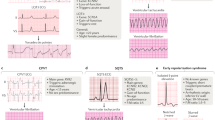Abstract
Cardiology has embraced the techniques of molecular genetics later than other medical disciplines but is now completely submerged in the genetic mapping of cardiac diseases. The techniques of molecular biology, and in particular, their application to the genetics of inherited diseases, have brought the clinician and the scientist together in an unparalleled dependence. The chromosomal mapping of genes responsible for disease requires the identification of families with inherited diseases. This step involves the cooperation of the clinician. In order to continue improving our understanding of the molecular basis, it is imperative to raise the clinician awareness of the role of genetics in cardiac diseases. Arrhythmias can also have a familial origin and it is not generally appreciated that atrial fibrillation could be inherited. In the last two years, we have identified more than 100 families all over the world with individuals affected by the familial form of the disease. With the techniques of genetic mapping we have identified an area on chromosome 10 that carries a gene causing the disease in some of the families and there is ongoing research to identify the specific mutation.
The clinician/scientist relationship has just started and the application of the discoveries in molecular genetics will probably have a direct role on how to approach medicine in the future, from prevention of diseases in patients carrying the susceptibility genes to gene therapy in those individuals with the disease.
Similar content being viewed by others
References
Roberts R, Towbin JA. Principles and techniques of molecular biology. In: Roberts R, ed.Molecular Basis of Cardiology, Hamden,CT: Blackwell Scientific Publications, 1992:15–112.
Marian AJ, Roberts R. Recent advances in the molecular genetics of hypertrophic cardiomyopathy. Circulation 1995;92:1336–1347.
Wang Q, Chen Q, Li H, Towbin JA. Molecular genetics of long QT syndrome from genes to patients. Current Opinion in Cardiology 1997;12:310–320.
Brugada R, Tapscott T, Czernuszewicz GZ, Marian AJ, Iglesias A, Mont L, Brugada J, Girona J, Domingo A, Bachinski LL, Roberts R. Identification of a genetic locus for familial atrial fibrillation. N Engl J Med 1997;336:905–911.
Marian AJ, Yu QT, Workman R, Greve G, Roberts R. Angiotensin converting enzyme polymorphism in hypertrophic cardiomyopathy and sudden cardiac death. Lancet 1993;342:1085–1086.
Feinberg WM, Blackshear JL, Laupacis A, Kronmal R, Hart RG. Prevalence, age distribution, and gender of patients with atrial fibrillation. Arch Intern Med 1995;155:469–473.
Albers GW. Atrial fibrillation and stroke: Three new studies, three remaining questions. Arch Intern Med 1994;154:1443–1448.
Wolff L. Familial auricular fibrillation. N Engl J Med 1943;229:396–397.
Girona J, Domingo A, Albert D, Casaldaliga J, Mont L, Brugada J, Brugada R. Fibrilacion auricular familiar. Rev Esp Cardiol 1997;50:548–551.
Brugada R, Bachinski LL, Hill R, Roberts R. Familial atrial fibrillation is a genetically heterogeneous disease. Am Coll Cardiol 1998;31:349A.
Author information
Authors and Affiliations
Rights and permissions
About this article
Cite this article
Brugada, R., Brugada, J. & Roberts, R. Genetics of Cardiovascular Disease with Emphasis on Atrial Fibrillation. J Interv Card Electrophysiol 3, 7–13 (1999). https://doi.org/10.1023/A:1009859119791
Issue Date:
DOI: https://doi.org/10.1023/A:1009859119791




